Whether it is the catchy “Ta Dum” sound of Netflix or the soulful sound of Nokia that we 90’s kids grew up listening to, nostalgia kicks in whenever we hear these tunes to date!
These tunes are ingrained in our minds. So much so that if we hear a tune that’s even remotely too close to these, we immediately remember these brands. Be it your favorite Netflix show or the good old Nokia phones. No wonder Spotify’s Culture Report shows that 63% of millennials and 65% of GenZs believe audio helps them experience situations more deeply.
What does this mean for content creators?
As a content creator, if you want to build a brand that instantly creates an impression in your audiences’ minds, nothing beats the power of music. The concept of building deeper insights with your audiences through audio is known as Sonic branding. Strategic sonic branding helps creators uniquely position content and build subconscious brand associations, like Netflix, McDonald’s, and Nokia.
But how do you build a Sonic brand? We have done some groundwork to provide you with the best Sonic branding tips and examples.
What is Sonic branding?
Sonic branding (or audio branding) is the process of building a strong identity where music or audio is the inherent part of the brand. Though we gave examples of Nokia and Netflix earlier, we know that Sonic branding is more than just a jingle or a simple tune. It is more about creating consistent sounds, music, audio elements, and background music to convey your brand’s message and personality.
Sonic branding is like a personal theme song that instantly reminds people of you. As you can recognize a famous movie or TV show by its iconic theme music, sonic branding allows your audience to associate specific sounds or music with your brand identity.
Historically, brands like McDonald’s have been nailing the concept of audio branding. As you read this sentence, you hear the “I am lovin’ it” sound in your mind.
But that doesn’t mean Sonic branding is limited to enterprises. Individual creators quickly instill Sonic branding in their content creation journey. They have to find a way to represent their thoughts and beliefs through audio.
Think of ASMR creators like HongyuASMR. Their YouTube channel has over 15M subscribers, and as you watch the videos, you will see how the creator leverages the slow and deliberate audio. Though there is hardly any loud music in the videos, the role of audio is distinct in each content.
That’s the power of Sonic music for content creators. It is timeless and a great way to:
Why should content creators care about Sonic branding?
When you hear the sound of Netflix’s “Ta Dum”, it instantly reminds you – “I have to finish watching that movie” or “The new season of my favorite show is coming next week; I will complete it in one sitting”.
Why do you think that happens?
We have an auditory sensory memory that stores sound information. Whenever we hear a familiar sound that’s already stored in this memory, we get nostalgic or think of taking action. A study by Gray Group shows that auditory stimuli influence customers’ behavior. The right background music or audio creates a positive atmosphere, soothes the audiences’ minds, relaxes the, and creates a context for a remarkable shopping journey.
TikTok’s report supports this. TikTok’s research report shows that sound-on TikTok campaigns do 2.2X better than sound-off campaigns.
If you are a content creator, here’s how audio branding will help you:
Build an emotionally available brand
Before developing a brand strategy, decide which brand emotion you want to target. When represented by colors, there are six different emotive spaces that creators should be aware of:
Music is one of those rare brand assets that helps you touch upon all of these emotive spaces. Music is no longer just a source of entertainment. Music drives all these activities, whether working out in a gym, busy with your daily chores, working hard in the office, or simply meditating.
Similarly, strategic brands use the power of music assets to convert a customer’s passion, frustration, fear or any other emotional expression into action. In today’s evolving state of customer experience, this approach helps brands foster a genuine emotional bond, rather than relying on forced selling tactics. And all that without forced selling but by building a deep emotional bond with the customers. Brands can even track how this relationship gets built over time by using customer success software including Catalyst alternatives.
As a content creator, do the same. For example, if you are a fitness influencer trying to establish the power of Yoga in building mental and physical strength, consider picking the ‘Goal-plan’ emotive space. Use calm and soothing music to de-stress your audiences and inspire them to adopt Yoga as a lifestyle choice.
Refresh or reposition your existing brand
Rebranding or repositioning is a risky game for brands. If not handled strategically, it often results in losing loyal customers. You may need to change the elements that make the audience recognize your brand, including the logo, and you can try to use an AI logo generator to get a logo that will present your new brand voice.
Refreshing your brand’s sonic identity is like giving a familiar song a new arrangement or remix. While the core melody remains recognizable, subtle updates and new elements can breathe fresh life into the tune, keeping it current and engaging for your audience.
If you have already established a Sonic brand, your audiences are familiar with your brand tune.
Add minor updates to your brand logo or audio to keep each rebranding initiative recognizable yet add a fresh perspective. A Sonic identity strikes the perfect balance between a brand’s existing identity that the customers remember and makes the customer curious about the brand’s new identity.
Broadcasting company NBC Chimes has been around since the 1930s, and here’s what their Sonic branding evolution looks like:
Improve familiarity and engagement
A viewer may not like your brand’s audio at first. Because different users have different choices when it comes to music. Someone likes it loud, while someone keeps it soulful and calm.
But it sure creates an interactive experience and, therefore, becomes memorable. If your brand’s music is catchy enough, it gets stored in their echoic memory, even though it is a little irritating initially. They hum it, start liking it, and become more curious about your brand.
Sonic branding best practices for content creators
Still having second thoughts about audio branding? Here are a few best practices and tips to help you get started with Sonic branding:
1. Research fellow content creators in the same space to find a differentiator
Differentiating your Sonic brand from your fellow creators is what makes a difference in the long run. Finding a unique sonic differentiator is like choosing a distinct musical instrument or vocal style for your brand’s theme. Just as a saxophone or a raspy voice can make a song stand out, a distinctive audio element can help your sonic brand cut through the noise and be instantly recognizable.
To find the differentiators, start with in-depth research into your industry and study your fellow content creators’ Sonic brands closely to find the following answers:
Play on your strengths and identify a differentiator through in-depth gap analysis. This will help you build a unique Sonic brand that represents your value proposition and differentiates your content from everyone else’s.
2. Use simple, original sounds
In Sonic branding, originality plays a major role. You cannot pick a theme or score simply because you like it. If it is already hugely popular music, played and replayed by a large number of users countless times, there will be no uniqueness whatsoever.
Instead, select an original music generation platform and customize the audio using mood- and emotion-based techniques.
Additionally, don’t complicate your Sonic brand’s audio with too many layers, beats, and instruments. Keep it simple and relatable.
3. Remember your target channel and the context of the sound
While establishing a Sonic brand is a good idea, you must also abide by the rules and regulations of your target channels. For example, if you create a lot of reels and shorts, use catchy audio, and communicate your content’s main aspects loud and clear.
Also, focus on the context of your audio. When creating shorts, the first few seconds of the content matter the most. If you hook the audiences in this very moment, they will watch the content till the end. Accordingly, keep it contextual and engaging, whether audio, a simple sound, or a voiceover.
4. Leverage the power of Generative AI
To create a sustainable, long-term Sonic brand, you need a source of royalty-free, original music. Regular music libraries are either costly or the choices are limited.
That’s exactly why creators should try out Generative AI music platforms. These AI music generators have features like text-to-music, unlimited customization, feedback sharing. That means, content creators are free to generate the music of their choice with text prompts, edit the generated music based on their desired genre and share detailed feedback on the generated tracks to help these platforms improve.
If you want to build a custom solution for your needs, Generative AI development services can help create tailored music generation tools.
Ready to build a Sonic brand?
All set to build your Sonic brand?
Let us help you out!
Try out a royalty-free, customizable, affordable AI music generator – Beatoven.ai to simplify Sonic branding for your brand.
Now, generate the music you want and your brand deserves in just a few seconds.

Sreyashi Chatterjee is a SaaS content marketing consultant. When she is not writing or thinking about writing, she is watching Netflix or reading a thriller novel while sipping coffee.


